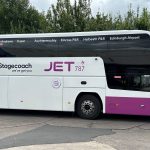Many in the industry agree with the suggestion that demand responsive transport (DRT) is destined to increase in prominence. In Essex, it is already being provided to a high standard and with great success through the DaRT network, operated by Arrow Taxi.
Working closely with Essex County Council (ECC), Arrow has taken over largely conventional bus services and converted them to minibus operation. Some are entirely demand responsive and others are to an extent. They all share a common trait: Huge passenger growth has been witnessed.
An example of Arrow’s work is on the Dengie peninsula. A previously fixed-route, low-frequency service with poor loadings became part of the Essex DaRT network. In its first year, usage grew by 173%, albeit from a low base.
Another operator is involved with the Dengie work. It took on an element of fixed route operation, which it has delivered reliably.
Andy Ambrose, who oversees Arrow’s minibus work, observes that on Dengie, the public benefitted from DRT and so did ECC. The subsidy required dropped considerably and service quality improved. Passenger satisfaction runs at close to 100%.
Essex DaRT uses a clever targeting of services
Across all its minibus work, Arrow steers away from competing with fixed-route services provided by other operators. Doing so would be pointless, says Andy. It is not what the network exists to do.
Instead, its focus is on capturing passenger trips that would otherwise have been made by private car or taxi. For a business that was built on taxi operation, that may sound odd. But it is actually entirely logical.

Another part of the Dengie DaRT network is service 99. It runs primarily from the peninsula to hospitals in Maldon and Chelmsford. It is largely demand responsive to the east of Hatfield Peverel. Beyond that it observes a fixed route and timetable. Notably, it is fully commercial.
A return to Chelmsford’s Broomfield Hospital is £10. That is a relatively high fare, but Andy points out that the flexibility of routing means that the service has more of a taxi feel to it. £10 is a lot cheaper than two taxi fares, he adds.
“That meant we immediately had a baseload of passengers that we could swap to the bus. With a demand-responsive service they were getting everything that they were previously. The only difference is that they were sharing with others – but for a quarter of the price,” says Andy.
As Arrow runs a large taxi fleet it has an easy solution to excess demand. It sends a car to pick up the odd passenger who cannot fit on the bus.
No additional charge is levied to the user when that happens. Andy accepts that, at the point of delivery, it represents a loss to Arrow. But he takes a holistic view: Such a level of service will generate repeat use. It will also lead to word-of-mouth recommendation.
Versatile approach to DRT from Essex DaRT
Other than service 99, most of the wider Essex DaRT network, which captures various parts of Essex, operates to no fixed route or timetable. The split between concessionary passholders and farepayers varies, but Andy says that journey cost is not the primary concern for many users.

“Reliability is by far the most important factor,” he adds. “We are expecting people to go out on a wet and windy day and catch the bus.
“If they have a car in the drive, it is the easiest thing in the world for them to use it instead. They have to be confident that the bus will arrive when we say it will.”
The flexibility of DRT is another major plus point. “We will reverse onto a customer’s drive if there is room to do so,” he adds. “That’s an extreme example, but passengers are picked up from their front door. That gives an overall journey ambience that is equal to that from a car.
“How we have an advantage is through the fact that parking is difficult to find at places like doctors’ surgeries, hospitals and at other traffic generators.”
No massive cost benefit for DRT
He says that while minibuses are cheaper to operate than conventional buses, when the additional expense of the staff that take bookings is factored in, the overall cost of provision is not hugely different.
Because of that, it is imperative that passenger numbers grow. Although most of Arrow’s minibus services, including much of the demand responsive network, are provided under contract to ECC, there is an incentive for it to build patronage.
As a result, it has seen capacity issues on some journeys. That has been addressed by duplication, rather than larger vehicles.
“We are configured around minibuses up to the Mercedes-Benz Sprinter bracket. If we went above that, we would need to re-equip the garage and expand the parking area.”
Another factor comes into consideration. Arrow observes a guideline of five minutes’ additional time per passenger pickup or drop-off. If larger vehicles were used, the cumulative impact could balloon, making the overall journey times less attractive.
No one minibus size fits all
There is a great deal of variety between Arrow’s DRT services. Where it took on a small amount of fixed-route work when another operator ceased trading, passengers there quickly heard about Essex DaRT and requested that their buses became demand responsive.
That was accommodated by Arrow, and even on its fixed-route sections it regularly adjusts services to soak up demand.
That has contributed to growth. Has customer loyalty done similar? In some cases it has, but it’s not one of the main reasons for rising patronage.
“It’s down to the practicalities of the service,” says Andy. “One of the big things for us is that our product is not the same in any two areas. It is adapted to fit the needs of users and it changes if they dictate.”
Although loyalty is not the primary driver of growth, Arrow places a strong emphasis on creating relationships between drivers and regular passengers. As a result, staff usually work the same routes each day.
“Both parties appreciate that. ECC also acknowledges the benefits it brings. It generates a sense of ownership on both sides. For example, when it is a passenger’s birthday, it’s not unheard of for a cake to be shared on the bus.”
Low floor EVM Citylines’ popularity
Arrow’s minibus fleet is made up of a variety of models. The newest are several EVM Citylines with a low entry section. Their introduction proved to be very popular among the passengers that use them. However, there was another side to their debut.

“We made a big thing about the Citylines when they arrived, and we got some good publicity. But the danger with that is that passengers on other routes see them and want their service to be operated by them too,” says Andy.
While a move to low floors is underway on DRT, how the sector in rural areas will transition from diesel is less clear.
Vehicles used on the DaRT network can cover over 300 miles per day. The flexible nature of the work, and the impact on demand that the weather can have, means that predicting usage and routing is difficult.
“I am sceptical whether we will ever see a battery electric minibus that offers sufficient capacity and a range of 400 miles. That would leave us reliant on charging during the day – but doing so will be difficult to schedule where we have neither fixed routes nor timetables,” Andy explains.
Doing the demand responsive basics well
As Arrow’s dominant source of business is its taxi fleet it is well-placed to draw a comparison between the back-office systems that are used in DRT and private hire car work respectively.
Andy’s view is that those in the latter are more advanced. They are better able to match demand with available resource, although given the number of taxi companies compared to the volume of DRT operations, that may be expected.
Arrow runs a lean organisation. Taking bookings as quickly as possible is key. It reduces the cost of providing the service and promotes efficiency.
And that is an important consideration. Conversion of poorly performing, low-demand conventional bus routes in Essex to DRT has seen patronage increase by huge amounts.
Andy points out that some operators are reluctant to commit to delivering an annual rise of 1%, but he does not pretend that DRT is a panacea.
It has worked well for Arrow Taxi in Essex, but there is no automatic guarantee that the model can be uprooted and moved elsewhere; he points to Chariot’s aborted efforts in London as one indicator of that. Instead, the concept needs to be tailored to local requirements.
“Doing that is imperative for DRT’s long-term success. The fare structure should recognise the fact that it is a premium, door-to-door service. But based on what we see in Essex, I believe that the demand responsive model will be an important part of the future public transport landscape.”
























